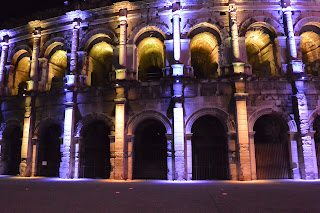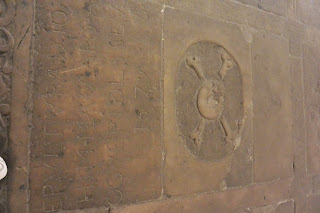I left Annecy France late in the day as I wanted to spend as much time with my friends there as I could. I booked the last train out of the town to Lyon France, which would get me back in the direction of Spain, knowing I would have to spend the night somewhere along the way. My three choices were Lyon, Nimes and possibly Narbonne, all in France. With the advice of my friends, I chose Nimes, a small village about halfway to my journey's end in Madrid.

Nimes is a village which surrounds a roman era and styled BullRing or collesium.
I got into town quite late but still decided to go out to explore the OldTown part of the village, while looking for a place to have some dinner. By this point, I'm getting used to eating dinner after 9pm and not finishing up until 11pm or later. The only saving grace is that I am walking a lot. So after dinner, a nice walk and picture taking session back to the hotel settles my constitution so I can sleep. Also bedtimes are quite late. It's not unusual to be texting after midnight with my friends on the plans for the next day.
I found a very elegant restaurant in old town, not the one the hotel suggested as that was closed but around the corner.
Nimes is French so I managed to alienate the wait staff with my poor french pronunciations. The good news is that I could read the menu, and not ask for an english translation. It was an interesting dinner. One of the items that came with the dinner was this very well cooked marrow bone with the marrow intact. I ate the marrow. trying to remember the health benefits of marrow. I know there are many.

So, dinner and desert of Flan and a good wine went very well so when done I headed back to the hotel.
Even at 11pm or later, and cold out, there are people on the streets. And the pictures at night are fabulous. At the bullring, there was a very large Ferris wheel.
Not sure what the french call it. But going to the restaurant, it was lit.
Coming home it was totally darkened. See the difference in the atmosphere with it lit, and festive, and not lit, and very pensive.
More pictures. Thru-out Europe, in small cities and large, they all have holiday decorations up at this time of year. And they are all very localized. each street has a style, different from the next street. But all lit up.
The rest of the pictures that survived Apples purge


























































